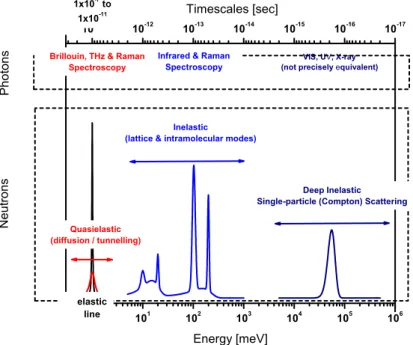This content has been downloaded from IOPscience. Please scroll down to see the full text.
Download details: IP Address: 160.80.2.38
This content was downloaded on 16/02/2015 at 12:08
Please note that terms and conditions apply.
View the table of contents for this issue, or go to the journal homepage for more 2014 J. Phys.: Conf. Ser. 571 011001
The VI Workshop in Electron Volt Neutron
Spectroscopy: Frontiers and Horizons
A.G. Seel,1
R. Senesi,2,3 and F. Fernandez-Alonso1,4
1
ISIS Facility, Rutherford Appleton Laboratory, Chilton, Didcot, Oxfordshire OX11 0QX, United Kingdom
2
Universit`a degli Studi di Roma Tor Vegata, Dipartimento di Fisica and Centro NAST, via
della Ricerca Scientifica 1, Rome 00133, Italy 3
CNR-IPCF Sezione di Messina, Messina, Italy 4
Department of Physics and Astronomy, University College London, Gower Street, London WC1E 6BT, United Kingdom
January 2014 saw the congregation in Abingdon (United Kingdom) of scientists from across the world, to discuss the current state and future of spectroscopy using epithermal neutrons. This meeting was the sixth in a series of workshops held in collaboration between the Science and Technology Facilities Council (United Kingdom) and the Consiglio Nazionale delle Ricerche (Italy), aimed at bringing together researchers with an interest in the use of electron-volt neu-trons in spectroscopic studies [1]. This technique is termed Deep Inelastic Neutron Scattering (DINS), and also Neutron Compton Scattering (NCS) in reference to the analogy with Compton scattering of X-rays from electrons. In particular, this meeting centred jointly around exper-imentalists and theoreticians, formulating animated discussions as to the current overview of DINS and future horizons facing the field.
The use of electron Volt neutrons for spectroscopic measurements dates back to the advent of proton-driven spallation neutron sources in the 1970s and 1980s. Following an initial scientific meeting in Los Alamos (USA) [2], the first two meetings in this series were held in Abing-don (United Kingdom) in 1995 and 1998, with subsequent meetings held in Santa Fe (USA) in 2005 [3], Oak Ridge National Laboratory (USA) in 2006 [4], and Rome (Italy) in 2010 [5]. The flagship instrument serving a continual user-programme for DINS measurements, and the main focus of this meeting, has been the VESUVIO spectrometer at ISIS [6, 7]. Subsequent instruments like SEQUOIA in the USA [8, 9] and a newer spectrometer in the Bariloche LINAC in Argentina [10, 11] have also been commissioned and began serving a growing user community. The availability of DINS measurements has extended the range of possible spectroscopic tech-niques that utilise neutrons into the kinematic region of high energy and momentum transfers, shown schematically in Figure 1. Spectroscopic instrument suites such as that of ISIS are thus able to probe processes on timescales across nine orders of magnitude, from quantum tunnelling and molecular diffusion up to nuclear recoil under the impulse approximation.
DINS is one of the most direct techniques for probing nuclear quantum dynamics in con-densed matter, with the ability to measure nuclear kinetic energies and momentum
distribu-10 0 10 1 10 2 10 3 10 4 10 5 10 6 Energy [meV] N e u t r o n s D e e p Ine la s t ic
Single - pa rt ic le ( C ompt on) Sc a t t e ring
Ine la s t ic ( la t t ic e & int ra mole cula r mode s )
Qua s ie la s t ic ( dif f us ion / t unne lling)
elast ic lin e
Figure 1. Energies and associated timescales accessible with neutron spectroscopy. The DINS regime remains the exclusive realm of accelerator-driven pulsed neutron sources.
tions of light nuclei. A major theme for current DINS research relates to the study of nuclear quantum effects, particularly regarding the non-classical behaviour of hydrogen or deuterium. This emphasis was reflected by the meeting’s opening session dealing with the measurement of momentum distributions in hydrogen-bonded and aqueous systems (see Table 1). Whilst concen-trating on experimental studies, data were presented from the outset alongside state-of-the-art path-integral molecular dynamics (PIMD) calculations, affording an animated discussion as to the interpretation of measured neutron Compton profiles in spatially disordered systems.
The extension of DINS to heavier nuclei was visited in the second session of the meeting, under the over-arching theme of MAss-selective Neutron SpEctroscopy (MANSE). The ability of DINS to examine atomically distinct species in condensed matter has garnered interest from the chemistry and materials communities, with both binary systems and more complex materials being presented in this session. Nuclei of interest in applied materials research were highlighted, including oxygen, lithium and fluorine, alongside an assessment of current capabilities and future developments in their examination by DINS.
The concluding session of the first day of the meeting was concerned with instrumentation. The detection of epithermal neutrons requires technologies unique relative to their lower-energy counterparts, and the first talk of this session outlined how detector capabilities on existing in-struments has been revolutionised in recent years. Resonance detectors and techniques involving analyser-foil cycling were detailed, explaining how they have improved not only the count-rate but also the spectral resolution of instruments such as VESUVIO. Beyond NCS, the detection of nuclear resonances were also considered. An overview of VESUVIO (a time-of-flight instrument operating in so-called indirect geometry) was then given, alongside ways it could be improved upon in light of growing demands from the user community. This discussion was complemented
Figure 2. Concluding photograph for the VI Workshop in Electron Volt Neutron Spectroscopy: Frontiers and Horizons, January 21st, 2014.
by a presentation of the use of direct-geometry instruments such as SEQUOIA for DINS mea-surements, highlighting the complementarity with parallel studies on VESUVIO.
The second day of the meeting was given over to the theoretical aspects of nuclear momen-tum distributions. Delegates were presented with the manner in which we can computationally incorporate nuclear quantum effects, along with their output in terms of ‘measureables,’ relating to a varied range of systems. Results were presented from hydrogen-bonded liquids, ferroelec-tric materials, biological systems, and mixed bosonic-fermionic calculations. The ability to now approach experimental measurement with theoretical insight, and vice versa, is a sea-change in research into nuclear quantum effects. This field is a high-profile area in chemical physics and materials research, and a concerted approach by theory and experimentation allows us to explore and explain the dynamical state of matter at the atomic level in a manner previously unobtainable.
Concluding each session throughout the meeting were periods of open discussion, wherein all present could comment or expand upon themes arising from the preceding talks. These discussions were then further distilled and clarified during the final section of the meeting, the ‘Frontiers and Horizons’ discussion, open to all present to delineate the next steps in DINS as a whole. Experimentalists and theoreticians were able to present their views on how each community could move forward to complement each other, not only separately but with specific projects and milestones in mind. These discussions have been included within these proceedings to highlight the future outlook of DINS.
It is the hope of these editors that this meeting will allow spectroscopy with epithermal neutrons to further develop, explaining the very quantum nature of dynamics in condensed matter. Bringing together, as it did, international researchers in fields at the frontiers of their respective experimental and theoretical communities, we hope that the next meeting in this series will see the fruition of concepts and projects instigated by this one.
Dr. Carlos Cabrillo, Consejo Superior de Investigaciones Cient´ıficas, Spain Prof. Michele Ceriotti, ´Ecole Polytechnique Federale de Lausanne, Switzerland Dr. Gregory Chasse, Queen Mary, University of London, United Kingdom Prof. Emeritus Roger Cowley, University of Oxford, United Kingdom Dr. Jesus Ivan da Silva Gonzalez, ISIS Facility, United Kingdom Prof. John C. Dore, University of Kent, United Kingdom,
Dr. Christof Drechsel-Grau, Ruhr-Universit¨at, Bochum, Germany
Prof. Felix Fernandez-Alonso, ISIS Facility and University College London, United Kingdom Dr. Nikitas Gidopoulos, Durham University, United Kingdom
Prof. Giuseppe Gorini, Universit`a Milano - Bicocca, Italy
Ms. Gabriella Graziano, University College London, United Kingdom Prof. Neville Greaves, Aberystwyth University, United Kingdom. Dr. Maria Grazia Izzo, Chalmers University of Technology, Sweden Dr. Martin Jones, ISIS Facility, United Kingdom
Dr. Philip King, ISIS Facility, United Kingdom
Dr. Winfried Kockelmann, ISIS Facility, United Kingdom
Dr. Maciej Krzystyniak, Nottingham Trent University and ISIS Facility, United Kingdom Prof. Dan Major, Bar-Ilan University, Israel
Dr. Jerry Mayers, University of Houston, United States of America Prof. Robert McGreevy, ISIS Facility, United Kingdom
Mr. Joshua More, University of Oxford, United Kingdom
Dr. Sanghamitra Mukhopadhyay, ISIS Facility, United Kingdom Dr. Stewart Parker, ISIS Facility, United Kingdom
Ms. Alexandra Parmentier, Universit`a di Roma - Tor Vergata, Italy
Dr. Keith Refson, STFC Scientific Computing Department, United Kingdom
Dr. Selena Richards, Nottingham Trent University and ISIS Facility, United Kingdom Mr. Giovanni Romanelli, Universit`a di Roma - Tor Vergata, Italy
Dr. Svemir Rudic, ISIS Facility, United Kingdom Dr. Kate Ryan, University of Oxford, United Kingdom
Dr. Christoph Salzmann, University College London, United Kingdom Dr. Andrew Seel, ISIS Facility, United Kingdom
Dr. Roberto Senesi, Universit`a di Roma - Tor Vergata, Italy Dr. Lukasz Walewski, Ruhr-Universit¨at, Bochum, Germany
Dr. Thor Wikfeldt, University of Iceland and Nordita, Iceland & Sweden Mr. Tim Wiles, Durham University, United Kingdom
References
[1] www.isis.stfc.ac.uk/news-and-events/events/2014
[2] www.osti.gov/scitech/biblio/5858602 and www.osti.gov/scitech/biblio/5860709 [3] www.fisica.uniroma2.it/vesuvio/dins/html/eV_workshop240405.htm
[4] www.ornl.gov
[5] web129.its.me.cnr.it/workshop/
[6] Mayers J and Reiter G 2012 Meas. Sci. Technol. 23 045902 [7] www.isis.stfc.ac.uk/instruments/vesuvio
[8] Granroth GG, Kolesnikov I, Sherline TE, Clancy JP, Ross KA, Ruff JPC, Gaulin BD and Nagler SE 2010 J.
Phys. Conf. Ser. 25112058
[9] www.neutrons.ornl.gov/sequoia
[10] Rodriguez Palomino LA, Blostein JJ and Dawidowski J 2011 Nucl. Instrum. Meth. A 646 142 [11] www.cab.cnea.gov.ar
Session 1 Nuclear Quantum Effects
13:15-13:55 Quantal Nuclear Motions in Condensed H-Bonded Systems
Carla Andreani, Rome
13:55-14:35 The Quantum Mechanics of Nano-Confined Water: New
Cooperative Effects Revealed with Neutron and X-Ray Compton Scattering
George Reiter, Houston
Session 2 DINS Beyond the Proton
14:55-15:35 MANSE and Beyond
Matthew Krzystyniak, ISIS
15:35-15:55 Origins of Mechanical Toughness in Bio-Cement During Setting
Gregory Chasse, Queen Mary University of London
15:55-16:15 Direct Measurement of Competing Quantum Effects on the
Kinetic Energy of Heavy Water Upon Melting Giovanni Romanelli, Rome
Session 3 Measurement and Instrumentation
16:20-16:50 Epithermal Neutron Detection at ISIS
Guiseppe Gorini, Milano-Bicocca
16:50-17:10 VESUVIO Now/VESUVIO When?
Andrew Seel, ISIS
17:10-17:35 Direct and Inverse Geometry Instruments for Proton Momentum
Distribution Studies Roberto Senesi, Rome Tuesday 21st January
Session 4 Theoretical Horizons and Calculation
09:00-09:40 Inexpensive Evaluation of the Quantum Kinetic Energy and Particle
Momentum Distribution by First-Principles Simulations Michele Ceriotti, EPFL
09:40-10:05 Collective Proton Tunnelling in Ordinary Ice
Christoph Dreschel-Grau, Bochum
10:05-10:30 Simulation Studies of Hydroge-Bonded Ferroelectrics
Thor Wikfeldt, Reykjavik/Stockholm
10:50-11:15 Interaction Induced Localisation of Protons: Temperature and
Superfluid Helium Solvation Effects Lukasz Walewski, Bochum
11:15-11:40 Nuclear Quantum Effects in Enzyme Catalysis From Momentum
Distributions Dan Major, Bar-Ilan

